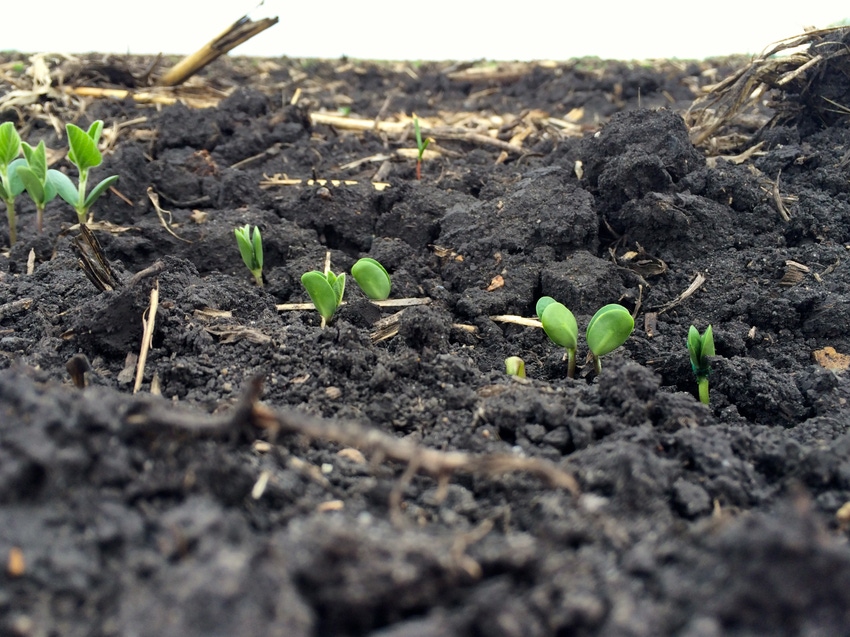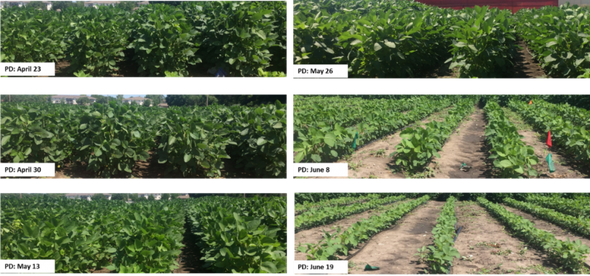
Benefits of early soybean planting
Early bird guide to higher soybean yield potential:Select full-season varieties with proven yield performance.Know your replant coverage with seed suppliers and insurance.Shoot for soil temperatures above 50°F during the 48 hours after planting.Time plant emergence knowing late-freeze probabilities.
April 25, 2016

Weather during the growing season (sunlight, temperature and rainfall) will ultimately determine the soybean yield potential in a given year. While it is difficult to predict the weather ahead, you have an opportunity to manage your planting date to increase the odds of achieving a higher yield in 2016.
Early soybean planting helps build a canopy that harvests most of the available sunlight, especially during crop stages that are crucial for yield formation. Canopy closure by the time soybean begins to set pods (R3 stage) should be the “holy grail” for soybean producers. Early planting will also ensure that pod set and seed fill occurs under high sunlight levels and that the crop will make best use of the season length to grow, leading to a higher number of nodes and seed number, and a longer seed-filling period.
We want our soybean fields to look “green to the eye” by early July, because this is the calendar time that coincides with R3 stage for late April or early May plantings in Nebraska in most of the years. In addition to increasing light harvest, early planting help maximize the fraction of available soil water used by the crop for transpiration relative to the amount of water that evaporates directly from the soil surface.
Know the early-planting risks
But how early is early? Assessing risk of a late spring freeze should be based on expected emergence rather than planting date. Remember that spring frost cannot kill the crop unless the growing tip is above ground. Depending on temperature, it may take 10-20 days for an early-planted soybean to emerge. And, by that time, the risk of a spring killing frost is extremely low across the range of environments where soybean is grown in central and eastern Nebraska. Replant coverage with crop insurance is set for April 25 across Nebraska. However, knowing your replant coverage options with seed suppliers may be more important. The percent replant coverage on seed cost from your seed supplier is likely based on seed treatment use and sales loyalty and neither policy is consistent across the industry.
An important consideration is that planting should be postponed if soil temperature (at seed depth) is expected to drop below 50° F during the first 48 hours after planting to avoid risk of seed chilling injury. Afterward, low temperature may delay emergence, but the germinated seed and seedlings will not die. An April 15 Cropwatch article, Three Key Considerations for Planting Corn and Soybeans, provides guidelines and recommendations for early soybean planting. The bottom line here is that if you take provisions to avoid seed chilling injury due to low soil temperature during the first 48 hours after planting, soybean can be planted during the last week of April and first week of May in central and eastern Nebraska with relatively low risk of spring frost.
Planting date, maturity group research
An irrigated experiment was conducted on the UNL East Campus during 2015 to assess the impact of planting date and maturity group on soybean yield. Two soybean varieties of contrasting maturity (MGs 2.1 and 3.0) were planted at approximately 10-day intervals, starting on April 23 and ending on June 19. Air and soil temperatures (2.5-inch depth) were monitored every half an hour, starting right after the first planting. Nighttime air temperature dropped well below 50° F during five consecutive days. However, soil temperature went down well below 50° F during only one night and, perhaps more importantly, it remained above 50° F during the first 48 hours after planting. Soybeans planted on April 23 and April 30 emerged on May 5 and May 15, respectively, when the risk of spring frost was extremely low. Hence, soybean planted on April 23 and April 30 did not experience plant damage due to low soil temperature during the first 48 hours after planting or late spring frost.
By early July, only the early-planted soybean had started to set pods (R3 stage) and were near 100% canopy closure (Figure 3). The “opportunity cost” for late-planted soybean was clear: Most sunlight hit the ground and was not used by the crop to accumulate dry matter and the crop did not reach R3 until late July. Hence, pod setting and seed filling of early-planted soybean took place earlier than for late-planted soybean (July-August for early plantings versus August-September for late plantings) and benefited from higher sunlight levels. Additionally, the crop cycle length (the number of days from emergence until maturity) of early-planted soybean was two to three weeks longer than for crops planted by mid-late May and June, while seed filling was three to four days longer.

Figure 3. Canopy cover in early July for each planting date in a 2015 Nebraska study. Authors note that fields that have closed canopy and are "green to the eye by the 4th of July" make the best use of sunlight to generate top yields.PD = planting date. Photo: University of Nebraska
As a result, yield was highest for early-planted soybean and we found a penalty of 1/8-1/4 bushel/acre per day of delay in planting for MG2.1 and MG3.0 varieties, respectively. But this penalty can be as high as 5/8 bushel/acre per day of delay as reported by previous Nebraska studies. The yield benefit of early-planted soybean has also been documented by the Nebraska On-Farm Research Network in experiments conducted in producer fields across south-central and southeastern Nebraska from 2008 to 2010. The yield penalty associated with late soybean plantings is not unique for Nebraska; several other north-central US states (Iowa, Illinois, and Indiana) have confirmed this penalty.
Interestingly, our study indicated that yield of the MG3 variety was higher relative to the MG2.1 variety in early plantings (late April and early-mid May), but the opposite (greater yield in MG2.1 versus MG3.0 variety) was found for late plantings (late-May and June). Hence, if early soybean planting is possible, consider using a little longer maturity that those recommended for later plantings for your area of Nebraska.
Do not miss the opportunity to increase your chances to get a high soybean yield in 2016. Plant early, get your soybean fields “green to the eye” by the 4th of July, and maximize both light and yield harvest.
You May Also Like



